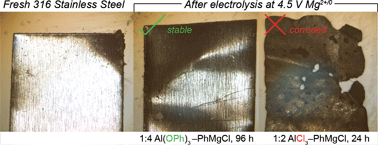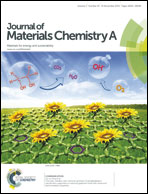A magnesium tetraphenylaluminate battery electrolyte exhibits a wide electrochemical potential window and reduces stainless steel corrosion†
Abstract
Using Al(OPh)3 rather than the typical AlCl3 with Grignard reagents affords a Mg-ion electrolyte with a reduced chloride content. A 1 : 4 Al(OPh)3–PhMgCl mixture gives a magnesium tetraphenylaluminate salt that exhibits anodic stability up to 5 V vs. Mg2+/0 on both platinum and stainless steel working electrodes, and shows much reduced corrosion (pitting) of stainless steel after extended electrolysis at 4.5 V.


 Please wait while we load your content...
Please wait while we load your content...